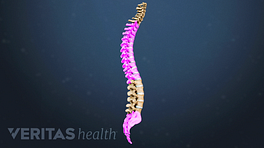Many people with back or neck pain seek alternative and complementary treatments—such as massage, spinal manipulation, or yoga—in addition to standard medical treatments. Here are some of the best alternative treatments to try for your neck or back pain. Check with your doctor and try a few to see what might work best for you.
Massage therapy
This treatment involves using the hands to manipulate the muscles, tendons, and other soft tissues to increase blood circulation and alleviate muscle tension. Regardless of whether your pain is mostly in the neck or back, massage therapy typically covers the neck, shoulders, and back because they’re all interconnected.
While you don’t need a vigorous massage to experience benefits, some research suggests that moderate-intensity massage offers more pain relief compared to light-touch massage. 1 Field T, Diego M, Hernandez-Reif M. Moderate pressure is essential for massage therapy effects. Int J Neurosci. 2010; 120(5):381-5. doi: 10.3109/00207450903579475.
See Neuromuscular Massage Therapy
Various types of massage are available to help relieve neck or back pain, including Swedish massage, deep tissue massage, and Shiatsu massage.
See Massage Therapy for Chronic Stiff Neck and Massage Therapy for Lower Back Pain
Spinal manipulation and mobilization
An osteopathic physician, chiropractor, or other health professional may use their hands to adjust the spine in an effort to improve joint mobility and reduce pain:
- Spinal manipulation involves a high-velocity, low-amplitude (HVLA) thrust. This type of maneuver typically involves a cracking sound that is commonly associated with a chiropractic adjustment.
- Spinal mobilization involves slow but firm movements of the spinal joints through their full range of motion.
While some studies have shown spinal manipulation and mobilization to have little or no effect on pain levels, 2 Evidence-Based Evaluation of Complementary Health Approaches for Pain Management in the United States. Mayo Clin Proc. 2016 Sep;91(9):1292-306. doi: 10.1016/j.mayocp.2016.06.007. , 3 Rubinstein SM, Terwee CB, Assendelft WJ, de Boer MR, van Tulder MW. Cochrane Database Syst Rev. 2012 Sep 12;(9):CD008880. doi: 10.1002/14651858.CD008880.pub2 other studies have found benefits in function and reduced pain. 4 Paige NM, Miake-Lye IM, Shekelle PG. Association of spinal manipulative therapy with clinical benefit and harm for acute low back pain. JAMA. 2017; 317(14):1451-60. Although, these benefits tend to be temporary and may work better in conjunction with other treatments, such as physical therapy. Before opting for a high-velocity spinal adjustment, it is important for any serious underlying conditions, such as spinal fracture, to be ruled out.
See Integrating Chiropractic Care with Other Doctors
Yoga
The ancient practice of yoga has increased in popularity around the globe in recent decades. While there are various types of yoga, this practice tends to focus on methodically placing the body in various poses while also incorporating meditation and breath control.
Improving the back’s strength and flexibility can help reduce back pain. Practicing yoga can help in this endeavor, in addition to helping to create a sense of calm and focus. Various studies have found yoga to help reduce neck pain 5 Cramer H, Klose P, Brinkhaus B, Michalsen A, Dobos G. Effects of yoga on chronic neck pain: a systematic review and meta-analysis. Clin Rehabil. 2017; 31(11):1457-1465. doi: 10.1177/0269215517698735 and lower back pain. 2 Evidence-Based Evaluation of Complementary Health Approaches for Pain Management in the United States. Mayo Clin Proc. 2016 Sep;91(9):1292-306. doi: 10.1016/j.mayocp.2016.06.007. Other exercise routines, such as Pilates, can also be beneficial. Just remember to start slow and do not perform any movements that increase pain.
Mindfulness and relaxation techniques
Practicing mindfulness, meditation, or other relaxation techniques may help you take your mind off the pain or at least feel more control over it. Some examples include:
- Breathing exercises. Try slow, controlled breathing until you start feeling yourself relax. There are many different types of breathing exercises, such as counting to 10 while you breathe in and then count to 10 again as you slowly exhale. It may help to go into a quiet room and sit in a reclined position.
- Altered focus. Think about a part of your body that is not hurting, such as your forehead. Now imagine it starting to warm up slowly. By focusing on a pain-free area experiencing an altered sensation, you can temporarily take your mind off the pain.
- Pain movement. Concentrate on the area hurting the most, such as your neck or lower back. Then picture the pain drifting into a nearby area, such as your shoulder. If you can, try picturing the pain moving even further from the pain source, such as into the hand, and eventually out of your body completely.
Alternative therapies tend to be safe
When performed by a qualified practitioner, alternative therapies are relatively safe. One study reviewed patient data from various alternative therapies—such as massage therapy, acupuncture, spinal manipulation, yoga, tai chi, and relaxation techniques—and did not find any serious adverse side effects that resulted from a therapy.
While alternative therapies tend to be safe in appropriately selected patients, it is important to have any neck or back pain that persists or is accompanied by numbness or weakness to first be evaluated by a physician.
It’s always best to check with your doctor before starting a new therapy, because he or she knows best how it may affect your specific condition.
Learn more:
- 1 Field T, Diego M, Hernandez-Reif M. Moderate pressure is essential for massage therapy effects. Int J Neurosci. 2010; 120(5):381-5. doi: 10.3109/00207450903579475.
- 2 Evidence-Based Evaluation of Complementary Health Approaches for Pain Management in the United States. Mayo Clin Proc. 2016 Sep;91(9):1292-306. doi: 10.1016/j.mayocp.2016.06.007.
- 3 Rubinstein SM, Terwee CB, Assendelft WJ, de Boer MR, van Tulder MW. Cochrane Database Syst Rev. 2012 Sep 12;(9):CD008880. doi: 10.1002/14651858.CD008880.pub2
- 4 Paige NM, Miake-Lye IM, Shekelle PG. Association of spinal manipulative therapy with clinical benefit and harm for acute low back pain. JAMA. 2017; 317(14):1451-60.
- 5 Cramer H, Klose P, Brinkhaus B, Michalsen A, Dobos G. Effects of yoga on chronic neck pain: a systematic review and meta-analysis. Clin Rehabil. 2017; 31(11):1457-1465. doi: 10.1177/0269215517698735










